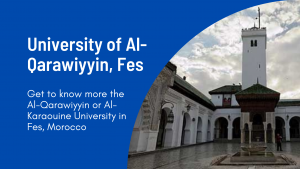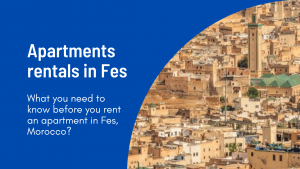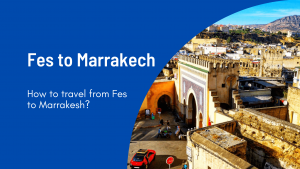The Hassan II Mosque, also called the Grand Mosque of Hassan II, is located in Casablanca. It is considered the biggest Mosque in Morocco, and the third-largest Mosque in the world, after Masjid Al-Haram in Mecca and Al-Masjid Al-Nabawi in Medina.
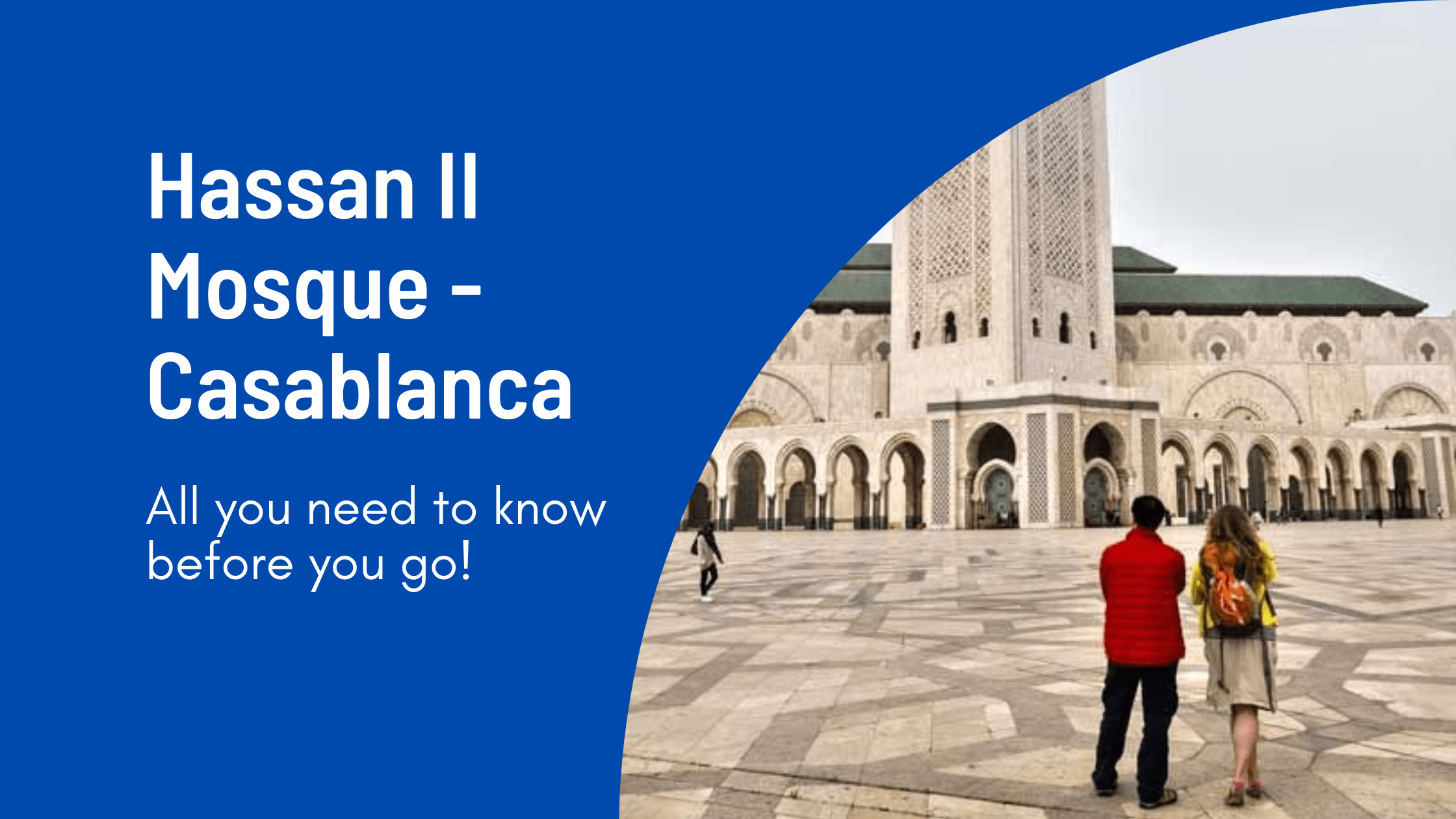
It is a masterpiece of Arab-Muslim architecture and one of the most beautiful religious buildings in the world. Ideally, it is one of the most unique in its architecture and size. Its minaret rises to 200 m in height and has a 30km laser directed towards Mecca, helping worshippers position themselves more precisely during prayers. A maximum of 105000 worshippers can gather together for prayers. The prayer hall can accommodate up to 25000 believers, while the boulevard is home to 80000.
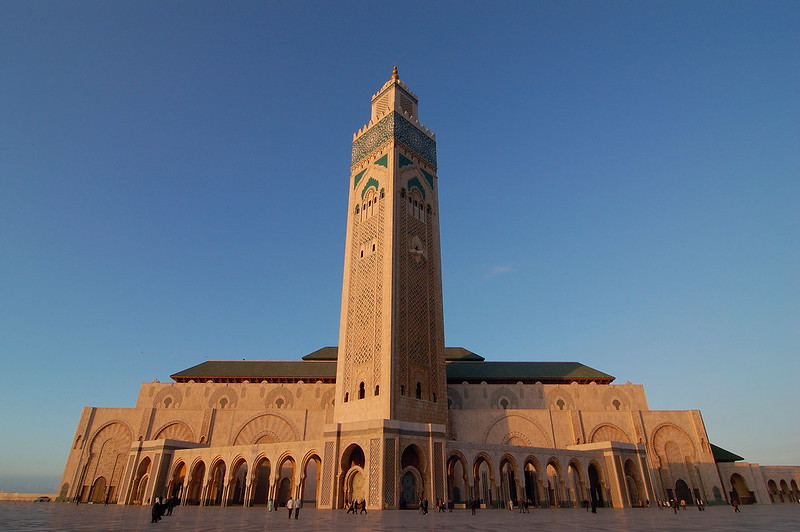
The idea of constructing the large Mosque in Casablanca reflects the Royal will to provide the Casablanca metropolis with a great spiritual and civilizational monument of Morocco, giving it a pleasant-sounding urban development and letting it rise its vivacity and influence founded on faith, religiousness, and tolerance.
Building the Hassan II Mosque
The foundation stone of the Mosque was laid by His late Majesty Hassan II; may his soul rest in peace. It was done on 11th July 1986. It was designed by French architect Michel Pinseau and built by Bouygues. The Mosque is built on an outcrop looking out to the Atlantic Ocean. The floor was made from glass, so the ocean below could be viewed, and believers could pray over the sea. The floor can also be heated when necessary.
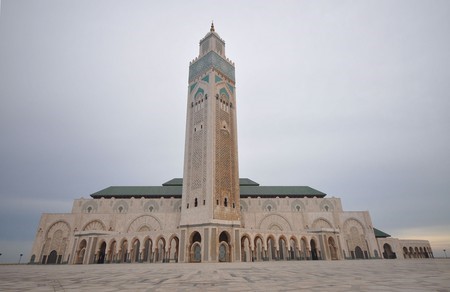
The walls of the hand-crafted marble. The roof of the Mosque is retractable so that it can be opened for believers to see the stars at night and feel the breeze during the warmer months. With the exceptions of the imported white granite columns and glass chandeliers from Murano, near Venice, close all the materials used in the construction of the Mosque are from Morocco. They used the finest materials from Morocco, such as cedarwood from the Middle Atlas Mountains marble from Agadir on the southern Atlantic coast.
The size and the elaborate decoration of the prayer hall are simply spectacular. The craftsmen were assembled to work on the Mosque, delicately carving intricate patterns and designs in fragrant cider wood from the Middle Atlas and pink granite from Agadir. The gates were made from brass and titanium, and the ablutions fountains in the basement, shaped like huge lotus flowers, were carved from local marble.
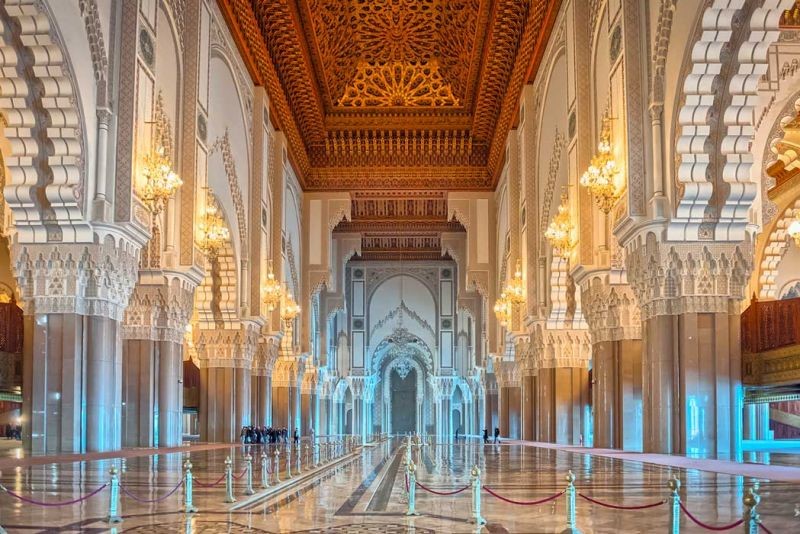
The construction works started under the effective and daily supervision of His Majesty Hassan II, who had made sure that this great building reflects the artistic specificities of authentic Moroccan architecture while highlighting its openness to technological innovations.
Through the architectural masterpiece, His Majesty Hassan II wanted to highlight the importance and value of the Hassan II mosque among Moroccans throughout history, just as He wanted to show that this place of worship has played an important role in the promotion of authentic architectural art and the preservations of the civilizational heritage, especially since the Casablanca Hassan II mosque reflects the great talents of the Moroccan Artisan.
The building on the Atlantic Ocean by the Quranic verse, “the throne of God upon the water,” was a ground-breaking idea envisioned to invite Muslim believers who go to this Mosque to remember the greatness of God who created the sea and the sky. He wanted the Mosque on the water because God’s throne is on water, and therefore the faithful would go, pray and praise the creator on firm soil, and contemplate God’s Ocean and sky.
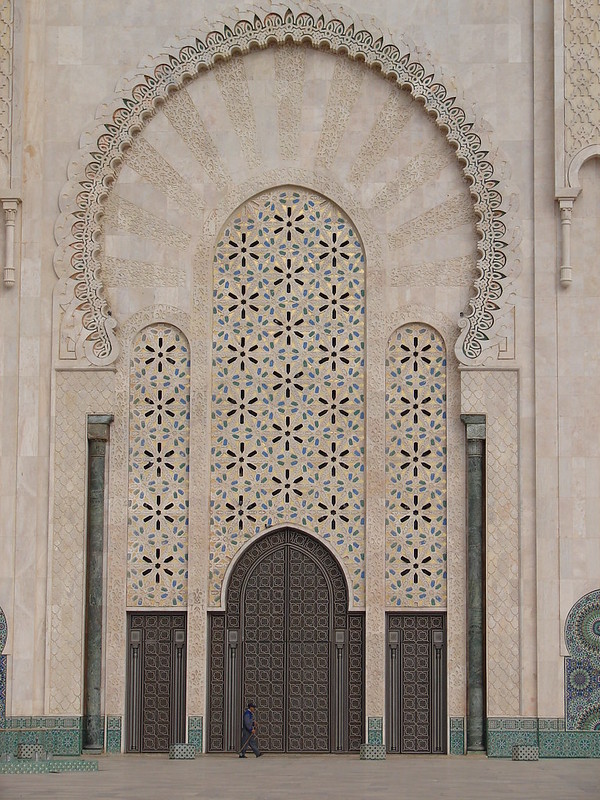
The architectural design of this work resulted from the collaboration between the office of the French architect Michelle PINSEAU and the numerous Moroccan artisanal bodies that have been created and revived by the hand of the master beauty and the splendid seal of Moroccan architecture.
The expression of the symbiosis between a king and his people the realization of the prestigious monument was financed, thanks to the participation of all the Moroccan people who voluntarily answered the Royal call, each according to their means and generosity. The building was then inaugurated on the celebration by the Muslim world, corresponding to 30th August 1993.
Hassan II Mosque Architecture and Fittings
The Hassan II mosque undeniably marks the continuity of a modernized ancestral art. It bears the sign innovations due not only to technical reasons but also to a fertile exploration of newfangled aesthetic possibilities. The Mosque measures 200 meters in length and 100 meters in width. All the materials used in the construction of the Mosque are plaster, marble, granite, wood, and other different materials. All were extracted in Morocco, with some exceptions of a few.
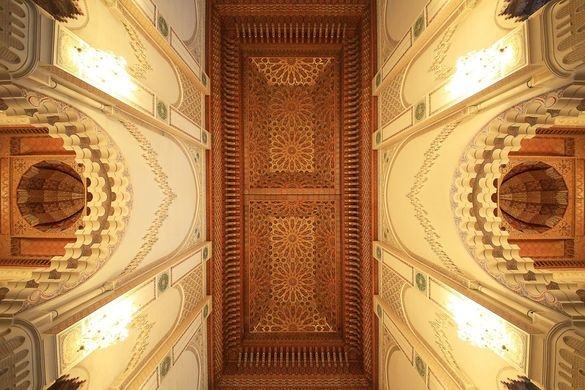
All the artisans involved in the construction of the Mosque ensured to create abundant and beautiful mosaics, stone and marble floors and columns, sculpted plaster moldings and carved and painted wood ceilings. The exterior surfaces of the mosque display bronze, titanium, and granite finishes.
The beautiful tile work also makes the Mosque looks so appealing and elegant. A particular feature in the Mosque is that all the structures are made of reinforced cement concrete, and all decorations are of traditional Moroccan designs.
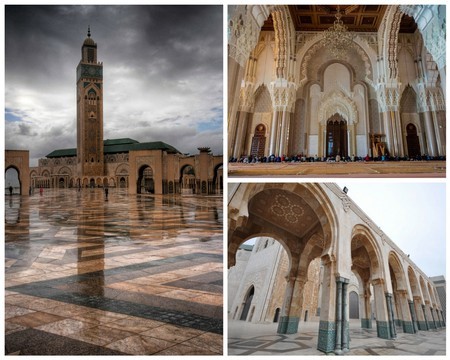
The notable architectural features include the conspicuous columns, horseshoe arches, and the innumerable muqarnas embellishing the ceilings.
The dome, arches, and walls give a grand ambiance to the Mosque. Also, the first-class sound system is discretely hidden, and the huge ablution room and a public hammam are in the basement, with their entrance. During the hammam baths, a Tedelakt a plastering technique that adds egg yolks and black soap into mixed plaster.
Design
The Mosque blends the Islamic architecture and Moroccan elements and reflects the Moorish influences while featuring an urban design. It displays elements found in the Moroccan building, such as the unfinished Mosque in Rabat and the Koutoubia Mosque in Marrakesh.
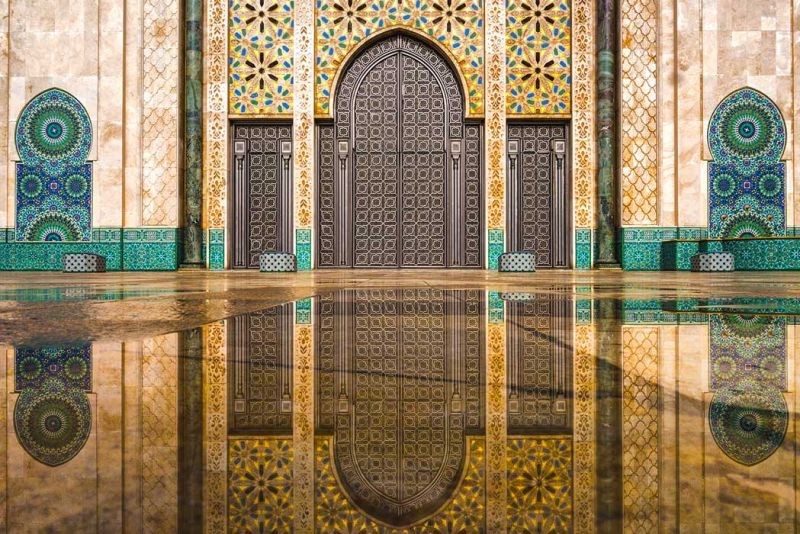
There are other features from the old Roman fort, which was converted into the tomb of King Mohammed V of Rabat. Other elements were borrowed from Tour Hassan Mosque, the Dome of the Rock, the Great Mosque of Madina, the Great Mosque of Damascus, the great Mosque of Cordoba, among others.
The layout of the Mosque is called the basilican plan, which is different from the common practice of a T-shaped plan, adopted in most North African countries. The qibla wall is perpendicular to the naves, which is said to be an unconventional layout, given that it is customary for the rows of worshippers facing Mecca to be as wide as possible, rather than the extended back.
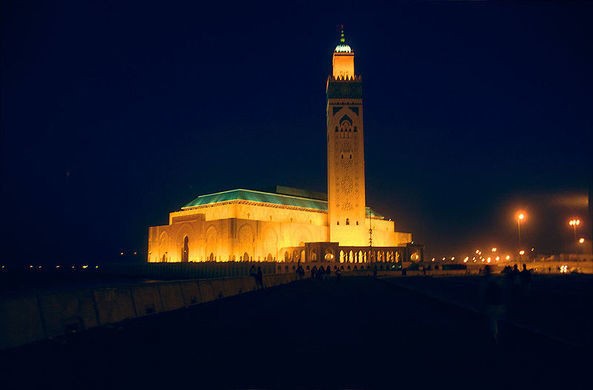
The plan’s adoption has been described as the occurrence of a conflict between King Hassan II, the ancient aristocrat, and King Hassan II, the contemporary leader who must develop commerce and industry to meet this country’s needs.
Prayer Hall
The prayer hall is built on the ground floor. The central hall is centrally heated and provides a spectacular underwater view of the Atlantic Ocean. The decorations on the wall are elaborate and exquisite made. The prayer hall is large such that it can accommodate St Peter’s of Rome. The wood carvings are also elaborate and highly impressive.

It is built to a rectangular plan of 200 meters in length and 100 meters in width, and three naves perpendicular to the qibla wall.
Hassan II Mosque History
The historical context of the Hassan II Mosque came about after the death of King Mohammed V in 1961. King Hassan II had requested the best county’s artisans to come forward and submit plans for the mausoleum to honor the departed king. He mentioned that it should reflect the enthusiasm and honor this renowned man was viewed.
In 1980, during his birthday celebration, Hassan II made his ambitions clear that he wanted a single landmark monument in Casablanca. The building was commissioned by King Hassan II to be the most ambitious architecture ever built in Casablanca, Morocco. The French architect, Michel Pinseau, was the one who designed it and lived in Morocco.
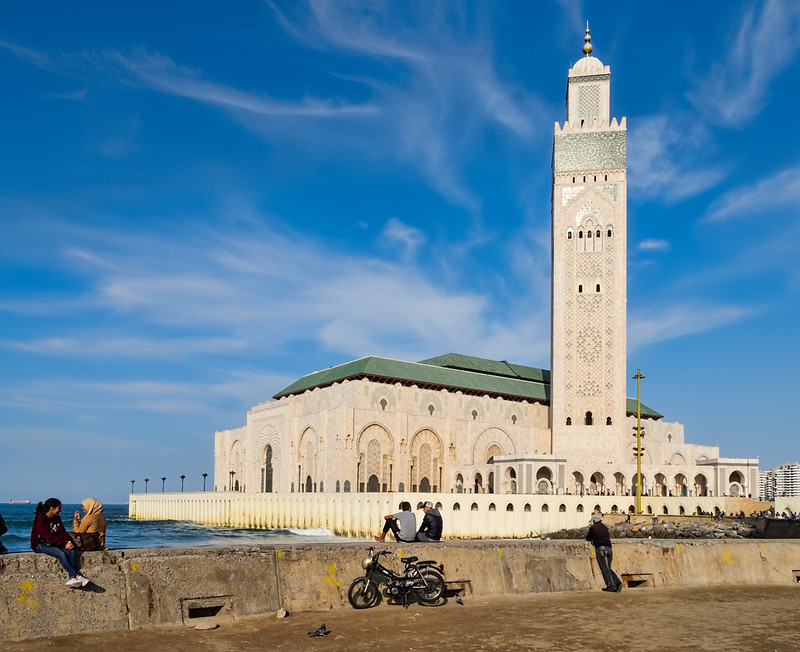
The civil engineering group Bouygues did the construction. In 1986, the construction of the building was begun and was conducted over seven years. The result is a massive modern tribute to the former King of Morocco that beautifully blends traditional Moorish architecture with 20th-century innovation and equipment. The building is capped with a spotlight that shines east towards Mecca. The Mosque was built with modern concerns in mind, such that it can withstand earthquakes and features a sliding roof and heated floor.
The conduction was set to be completed in 1989, ready for king Hassan II’s 60th birthday. This period was the most intense construction period, with 1400 men working during the day and other 1100 men working during the night. Everyone worked extra hard to ensure the building was completed in time.
Ten thousand artists and craftsmen contributed to building and beautifying the Mosque. However, the building was not completed on schedule, which delayed inauguration until August 1993. This marked the even of the anniversary of Prophet Muhammad’s birth and the time it was dedicated to the sovereign of Morocco.
The exterior provides an up-close look at some of the finest tile work in pale blues, ivories, and yellows when wandering around. You cannot afford to miss the extravagant prayer hall where the retractable ceiling opens up, providing worshippers with gentle ocean breezes.
If you are a non-Muslim, you must join a tour group- numerous tours are offered throughout the day. Still, time changes depending on the prayer schedule, and dress respectfully to access the prayer hall, ablutions room, and hammam.
Financing
The estimated costs of construction are about 585 million euros. This was an issue of debate in Morocco, a lower mid-income country. Hassan II wished to build a mosque that would be the second-largest in size after the Mosque in Mecca. The government lacked such funds for use in a grand project.
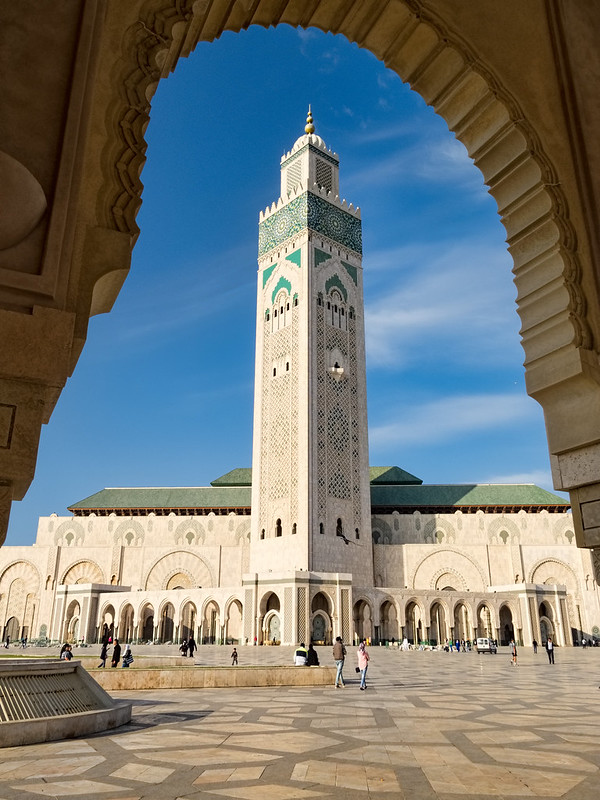
Much of the funding was done by public subscription. Twelve million people donated to the cause, with a receipt and certificate given to every donor. The smallest contribution was 5DH. In addition to the public donations and those from business establishments and Arab countries such as Saudi Arabia and Kuwait, the western countries provided construction loans which Morocco repaid.
What to know before you go
There are tours available in multiple languages and are required if you are not Muslim. You don’t need to cover your head, but your knees and shoulders should be covered. The tours run from Saturday through Thursday at 9 AM, through to noon, and from 3 PM to 4 PM. On Fridays, tours are done from 9 AM to 11 AM and 4 PM.
The tours last for about 45 minutes and are conducted in French, English, German, and Spanish, and take in the prayer hall and subterranean ablutions rooms.
You should also check for any changes in time schedules during Ramadan on their official website. Entrants are required to remove their shoes- so plan your socks accordingly. But you are provided with a small bag to carry them on your tour. There is also underground parking available nearby, so you don’t have to worry about driving your car.
Visiting the Hassan II Mosque as a non-Muslim
The Mosque is always open to Muslims at daily prayer times and special Friday services. It is one of the few mosques open for non-Muslims to visit. However, don’t get this twisted- guided tours are the only way for non-Muslims to enter the Mosque at specified times.

No entrance fee if you visit the outside, but if you are looking to get inside, then a small fee is charged, and a tour guide to show you around.
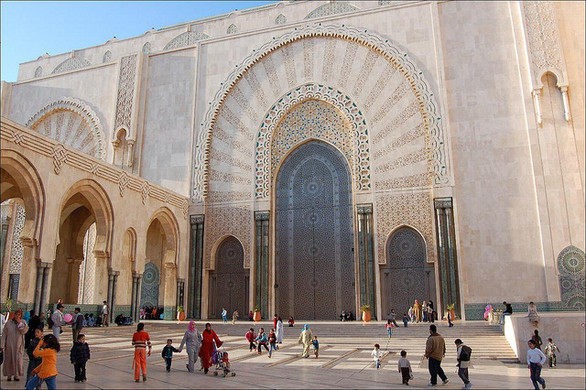
The museum in the Hassan II mosque
The Mosque has a small museum attached. There are numerous details on the mosaic and wood cravings in the Mosque, making it a great attraction site. There are no entrance fees charges- feel free to learn more about the Mosque and Casablanca at large.
In conclusion
Hassan II Mosque Casablanca is the best place to visit. While there, you should observe etiquette and honor to the holy places. For example, women are not forced to cover their hair. However, both men and women must cover their shoulders and chest and dress long enough to cover their knees. Men and women are forbidden to wear shorts and short shirts. In addition, no smoking, eating, or drinking is allowed in the Mosque.
The Hassan II Mosque on the Map
Hand-Picked Related Articles
- Is Casablanca Safe?
- Best Casablanca Resorts
- Casablanca Weather
- 14 Best things to Do in Casablanca
- Best Places to Stay in Casablanca
- Casablanca 5-Star Hotels
- Best Restaurants in Casablanca
- Car rental in Casablanca Morocco
- Shopping in Casablanca
- Casablanca to Marrakech 5 Ways to Travel
- Morocco Tours From Casablanca

